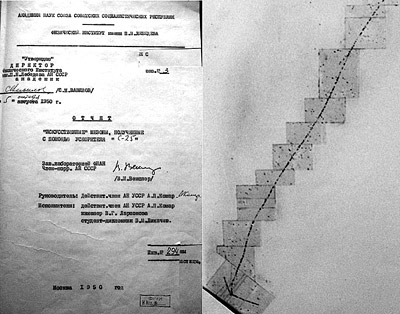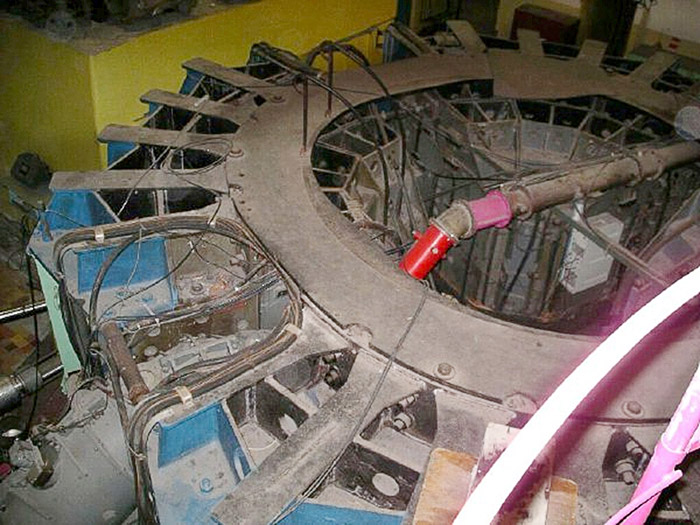
Electronic english version since 2022 |
The newspaper was founded in November 1957
| |
In the laboratories of the Institute
From the first observations of cosmic rays
to the physics of relativistic nuclei
High-energy particle accelerators are sometimes figuratively called "Pyramids of the 20th century." These largest instruments for understanding the microworld deserve such high praise not only for their impressive size, but also for the significant impetus that their development gave to collective creativity in science and technology. Our era has a chance to go down in human history as the "cultural layer of synchrotron builders". The longevity of facilities of this class is based on the possibility of their qualitative improvement as fundamental research carried out on them deepens and applied developments develop.
In 2023, the 70th anniversary of establishment of the Veksler and Baldin Laboratory of High Energy Physics of JINR was celebrated. Several generations of its employees and colleagues in the JINR Member States have traveled a glorious and dramatic path. Its stages included the first experiments at the synchrophasotron in particle physics, the establishment of research in relativistic nuclear and polarization physics and the development of a specialized synchrotron based on superconductivity - the Nuclotron. Since the beginning of the 1970s, experiments at the cutting edge of particle physics have been developed at the Institute of High Energy Physics (USSR), Fermi National Accelerator Laboratory (USA) and the European Organization for Nuclear Research (CERN).
A long-term perspective at VBLHEP opens up the implementation of the NICA megaproject for studying quark-gluon degrees of freedom of nuclear matter using extracted and colliding beams of heavy relativistic nuclei and polarized protons with an energy of several GeV per nucleon. The phased development of the project expands the capabilities of experiments in nuclear physics and radiation biology, as well as in related applied areas. An important milestone of the NICA project in 2023 was the acceleration of xenon nuclei to 3.8 GeV per nucleon. To date, the accelerator cascade includes an electron beam source, a new linear heavy ion accelerator HILAC, a new superconductivity booster and a Nuclotron with beam extraction systems for VBLHEP experiments. Such large-scale development would hardly have been possible without the material and intellectual capital accumulated over previous decades. This capital includes priority physical results obtained on the developing accelerator and experimental base. It is based on achievements in the field of cosmic ray physics of the Soviet period.
The organizational origin of VBLHEP is taken to be the establishment of the Electrophysical Laboratory of the USSR Academy of Sciences (EPLAS) in 1953 as an institute within the Department of Physical and Mathematical Sciences to implement research in the field of high-energy physics at the synchrophasotron under construction. EPLAS was headed by V.I.Veksler, a recognized leader in cosmic ray research in the 1930s and 1940s, as well as the leader of the construction of the first synchrotrons based on the autophasing principle he had discovered. In 1956, EPLAS joined JINR as the Laboratory of High Energies (LHE). EPLAS replaced the TDC - the technical directorate of construction, where future VBLHEP employees were accepted. When LHE was united with the Laboratory of Particle Physics in 2008, the name was given - VBLHEP.
One of the key moments in the development of high-energy physics was the observation of traces of particles with momenta above 20 MeV/c in a cloud chamber positioned in a magnet by D.V.Skobeltsyn, in 1927 that indicated the corpuscular nature of cosmic radiation. The further research of cosmic rays was carried out at the Atomic Nucleus Laboratory of the Physical Institute of the USSR Academy of Sciences headed by D.V.Skobeltsyn. New detection techniques were required to meet fundamental issues. To study the nature of cosmic rays, V.I.Veksler that was a recognized specialist in Geiger counters became a member of the complex expedition of the USSR AS on Elbrus. In 1937, Soviet physicist N.A.Dobrotin at the II All-Union Conference on the Atomic Nucleus (UFN, 1937) noted the following:
"V.I.Veksler reported to us on the application of the original technique he developed to the investigation of cosmic rays. It consists of using gas proportional amplifiers operating according to a coincidence circuit to count particles. It allows to determine not only the number of particles that have passed through these counters, but also to measure the ionization they develop. V.I.Veksler worked with such a facility this summer during an expedition to Elbrus. It turned out that at an altitude of 4200 m above sea level there are easily absorbed and highly ionized particles. At sea level, the number of such particles is noticeably smaller than at the height of Elbrus. Their number is so small that these observations cannot be reconciled with the assumption of the occurrence of an intense proton component in cosmic rays. In addition, V.I.Veksler obtained indications of the secondary nature of these particles. A number of authors have pointed out the occurrence of such particles before. But this is the first time they have been discovered with such clarity. Thus, already the first experiments with proportional gas amplifiers gave very valuable results. And there is no doubt that the further use of this technique will allow us to achieve very significant successes, both in the research of heavy particles and showers."
 |
| The title page of the FIAN report and a photograph of the tortuous trace of a ϖ meson captured by an emulsion nucleus with the production of two fragments (courtesy of S.P.Kharlamov) |
Future LHE professors K.D.Tolstov, A.L.Lyubimov, M.I.Podgoretsky that headed the first scientific teams at the synchrophasotron, went through Veksler's school in the Pamir expedition. The tasks of post-war reconstruction and defense of the country did not encourage academic spending in the harsh environment of the 1940s. However, due to the fact that the non-military nature of this area was not obvious at the initial stage, fundamental research in this area received unprecedented support within the framework of the USSR Atomic Project. The very logic of the research required laboratory conditions for a targeted investigation of the birth of particles, identifying their internal structure and searching for unknown particles and antiparticles. The epoch-making principle of autophasing, independently proposed by V.I.Veksler in 1944 and E.McMillan in 1945 in the USA, met the issue of developing accelerators on a cosmic energy scale.
At the end of the 1940s, under the supervision of V.I.Veksler, electron synchrotrons were developed: at 30 MeV for studying photonuclear reactions (S-3, "troika") and at 250 MeV (S-25). The thesis of I.V.Chuvilo, dedicated to the production of neutrons using γ quanta, became the first at S-3. At S-25, with the help of the Ilford nuclear emulsion, the production of ϖ-mesons using γ-quanta was discovered. It marked the beginning of the physics of electromagnetic interactions of hadrons that was then figuratively called the "nuclear properties of light." The main area was the research of the production of charged and neutral mesons on nucleons, the polarizability (deformability) of nucleons in Compton scattering of γ quanta. In general, the experiments demonstrated the possibility of describing hadronic physics based on quantum field theory.
Young physicists that later took leading positions in scientific centres began research on S-25: M.I.Adamovich, A.M.Baldin, A.S.Belousov, B.B.Govorkov, V.I.Goldansky, A.N.Gorbunov, Yu.M. Ado, S.P.Denisov, R.M.Lebedev, M.F.Likhachev, V.I.Moroz, A.P.Onuchin, L.N.Strunov, E.I.Tamm, I.V.Chuvilo, L.N.Shtarkov. This list is almost certainly not complete. Mastering the injection and acceleration of slow protons required the development of a prototype of MKM synchrotron (directed by V.A.Petukhov and L.P.Zinoviev), on which protons were accelerated to 160 MeV. Noting this success, V.I.Veksler said that the synchrophasotron "on the Volga" will definitely operate. Later, MKM was converted into the S-60 electron accelerator and served at the Lebedev Physical Institute as a source of synchrotron radiation until dismantled in the 2000s.

MKM synchrotron at Lebedev Physical Institute. 2007
At the Lawrence Berkeley Laboratory (USA), under the supervision of E. McMillan, a weakly focusing synchrotron was developed to accelerate protons to 6 GeV. Thanks to the developments that were carried out in laboratories under the supervision of V.I.Veksler and A.L.Mints, the Soviet response to the Americans was the launch of a synchrophasotron with a proton energy of 10 GeV in the spring of 1957. The physical substantiation of the technical project was developed in 1950 by V.I.Veksler's group that included A.M.Baldin, A.A.Kolomensky, A.P.Komar, V.V.Mikhailov, M.S.Rabinovich. It is worth noting that based on their research experience, the Fianovites, headed by M. A. Markov, insisted on an electronic version that was held in the 1960s headed by E.I.Tamm as S-25R in the department of high-level physics energies of the Lebedev Physical Institute in Troitsk. In the case of the synchrophasotron, the point of view of physicists associated with Laboratory No.2 of I.V.Kurchatov that advocated the proton option, won. This choice determined the scientific fate of LHE 20 years later: the emergence of relativistic nuclear physics on the basis of the synchrophasotron.
Thus, the era of peaceful competition in the physics of the microworld began. Soon, it allowed to develop science cities and accelerator centres in the USSR, the USA and Western Europe, already open to the widest international cooperation. They can be considered general milestones of human progress over the past decades. In the autumn of the same year, the first artificial satellite was launched - piccola luna russa ("little Russian Moon"), according to one of the newspaper headlines abroad, as A.M.Baldin recalled.
To be continued
Pavel ZARUBIN,
Head of the Thick-Layer Emulsion Processing Sector at VBLHEP